Abstract
The plant growth regulator ethylene influences rachis browning in grape (Vitis vinifera L.). Although the ethylene signaling pathway is well defined, there is limited knowledge on its mode of action during rachis browning. Here, we show that an ethylene response factor (VvERF111) positively regulates chlorophyll degradation in rachis by binding to a DRE motif in the promoter of VvCLH1. The expression of VvERF111 and VvCLH1 in rachis was induced by ethylene and inhibited by 1-methylcyclopropene (1-MCP). VvERF111 belongs to the ERF IX subfamily of the APETALA2/ethylene responsive factor (AP2/ERF) superfamily, shows transcriptional activity in yeast, and is localized in the nucleus and membrane. The transient overexpression of VvERF111 or chlorophyllase (VvCLH1) in grape leaves accelerated chlorophyll degradation. In VvERF111-overexpressing leaves, transcript levels of VvCLH1 were also increased. Our findings offer a deeper understanding of the transcriptional regulation of chlorophyll degradation during the rachis browning of grape.
1. Introduction
Fruit and stem color are highly visible indicators of fruit quality to consumers. Grape is cultivated, shipped, and consumed worldwide. After harvest, the storage and shipping of table grape must be carried out in a way that maintains the overall quality of the bunches. The priority is the prevention of berry decay, but rachis browning must also be considered [1]. To the consumer, green main stems and individual rachis to each berry are indications of freshness, while brown rachis can be a major cause of consumer rejection and, eventually, fruit waste. Rachis browning is also a big problem during post-harvest storage. Water loss is one of the key factors in rachis browning [2]; however, rachis quality also varies during prolonged storage under high relative humidity [2]. This indicates that there are additional factors participating in rachis browning.
Chlorophyll is the key pigment for photosynthesis, which most living plants depend on. Chlorophyll is subject to both catabolic and anabolic metabolism. The color change of leaves in autumn and of fruit during ripening are conspicuous examples of the degradation of chlorophyll [3,4,5]. Chlorophyll degradation-related genes and enzymes have been studied in a range of plant species and include chlorophyllase (CLH), oxygenase (PAO), pheophytin pheophorbide hydrolase (PPH), RCC reductase (RCCR), and yellowing1/stay-green1 (NYE1/SGR1) [6,7,8]. CLH is a rate-limiting enzyme during chlorophyll breakdown [9]. Transgenic broccoli (Brassica oleracea var. italica) expressing an anti-sense chlorophyllase (BoCLH1) shows delayed post-harvest yellowing [10]. Chlorophyll catabolism has not been well-studied in grape rachis, but it is known that chlorophyll content is reduced and the expression of chlorophyll degradation genes is increased during rachis browning [11,12].
Ethylene is one of the causes of rachis browning. Although grape is considered a non-climatic fruit that does not exhibit a large rise in ethylene production or respiration rate, a study showed that grape rachis can produce more ethylene than grape berries during fruit ripening [13], which leads to rachis browning. Furthermore, ethylene treatment enhances rachis browning, while treatment with the ethylene action inhibitor 1-MCP inhibits it [14,15]. 1-MCP treatment also suppresses the expression of chlorophyll degradation genes in the skin of pears [16]. Chlorophyll degradation can be enhanced by ethylene treatment [17].
The ethylene response factor (ERF) is transcription factors within the ethylene signaling pathway that is associated with chlorophyll levels, either by increasing its degradation or by suppressing its synthesis [18]. The ERF members recognize GCC-box cis-acting elements (AGCCGCC) and DRE motifs in the promoters of ethylene-responsive genes to regulate their expression [4,5]. For instance, AtERF4 binds directly to the AtCLH1 promoter and increases its expression [19]. AtERF72 directly binds to the AtCLH1 promoter under iron deficiency [11]. CitERF6 and CitERF13 in citrus and MdERF17 in apple regulate chlorophyll degradation during the degreening of the fruit peel [4,5,20,21]. Last year, we reported that VvERF95 participates in grape rachis browning by regulating the expression of VvPAO1 [12], while another group showed that VvERF17 regulates chlorophyll degradation in grape berry skin [17]. In tomato, SlERF.J2 regulates expression of a chlorophyll synthesis gene [18]. Together, these reports suggest that ERF transcription factors have conserved functions in chlorophyll catabolism. In our previous study, VvERF111 was differentially expressed in the grape cluster, showing higher expression during rachis browning [22] and a negative correlation with chlorophyll content. These preliminary results indicated that VvERF111 has a potential role in chlorophyll degradation during rachis browning.
In order to understand the role of VvERF111 during rachis browning, the transcript levels, protein localization, and functional activity of VvERF111 were characterized. We demonstrated that the ERF IX subfamily gene VvERF111 contained a conserved AP2/ERF domain, showed transactivation activity in yeast cells, and localized to the nucleus and membrane. VvERF111 could bind to the DRE motif in the promoter of the chlorophyll degradation gene VvCLH1, to up-regulate its expression, which resulted in accelerated degradation of chlorophyll. The data presented here furthers our deciphering of the mechanisms of rachis browning in grape.
2. Materials and Methods
2.1. Plant Materials
Five-year-old vines of the grape cultivar ‘Shine-Muscat’ (Vitis labruscana Baily × Vitis. vinifera L.) were maintained in a commercial vineyard (Zhengda Vineyard, Zhengzhou City, Henan, China) under normal growth conditions. Clusters of similar size and maturity were selected and used for 1-MCP treatment, as we previously reported [12]. Three biological replications were carried out for the whole experiment.
2.2. Gene Isolation and Sequence Analysis of VvERF111
The full-length coding sequence (CDS) of VvERF111 was cloned from Shine Muscat using primers listed in Table S1. Sequences of ERF genes in Arabidopsis and homologous genes were downloaded from the TAIR and NCBI databases. Sequence alignments and phylogenic trees were generated using MEGA7 according to a previous report [23]. Promoter sequences (1500 bp) upstream of the ATG start codon of chlorophyll degradation genes were download from the grape genome (12 X). The DRE motif (A/TCCGAC) was manually queried in the promoter of VvCLH1.
2.3. Transcriptional Activation Activity
The CDS of VvERF111 was inserted into the vector pGBKT7 (BD) using the NdeI and PstI restriction sites, to yield pGBKT7-VvERF111. The empty pGBKT7 vector was used as a control. pGBKT7 and pGBKT7-VvERF111 were transformed into yeast strain Y2HGold and then grown on SDO (Single Dropout, SD-Trp) for three days. Colonies were spot plated onto SDO, SDO/A, and SDO/A/X to observe yeast growth. Primers used in this study are listed in Table S1.
2.4. Subcellular Localization Analysis
The CDS of VvERF111 (without the termination codon) was introduced into the pSAK277-GFP expression vector digested with EcoRI under the control of the CaMV 35S promoter. The constructs 35S-VvERF111-GFP and pSAK277-GFP were introduced into A. tumefaciens GV3101, which was then transformed into Nicotiana benthamiana leaves. After incubation for 48 h, the fluorescence was detected by laser confocal microscopy.
2.5. Yeast One-Hybrid Analysis
The CDS of VvERF111 was cloned into the pB42AD vector in restriction enzyme sites EcoRI/XholI, and promoter sequences of the chlorophyll degradation genes VvSGR, VvSGRL, VvCLH1, VvPAO1, VvRCCR, and VvNOL were inserted into the pLaczi vector ligated into the Placzi vector in restriction enzyme sites KpnI/SalI. The VvERF111 and promoter sequence constructs were co-transformed into yeast EGY48 [5,24]. The transformants were cultured on SD/-Trp/-Ura and on SD-Gal/Raf-X-gal solid media, and observed after 2 to 3 days. To further identify which cis-element in the promoter of VvCLH1 can be bound by VvERF111, the promoter sequence of VvCLH1 was divided into three segments. Each segment was tested for activation by VvERF111, and the segment that could interact with VvERF111 was further divided into six segments and tested; the mutation of DRE mitif was conducted in segment to verify if it was the key cis-element bound by VvERF111. All primers were constructed as shown in Table S1.
2.6. Dual Luciferase Assay
The VvCLH1 promoter region was inserted into the pGreenII0800-LUC vector digested with KPNI and NCOI to yield the reporter construct [25], and the CDS of VvERF111 was introduced into pSAK277 to yield the effector construct, with pGreenII0800-LUC and GFP used as negative controls. The constructs carrying VvERF111 and the promoter of VvCLH1 were injected into N. benthamiana leaves [26]. LUC and REN luciferase activities were determined with a dual luciferase reporter kit (Dual-Luciferase Reporter Assay System, Promega, Madison, WI, USA). Each reaction was performed in six replicates.
2.7. Transient Overexpression of VvERF111 in Grape
35S-GFP, 35-VvERF111-GFP, and 35S-VvCLH1-GFP were individually transformed into A. tumefaciens GV3101. Fully expanded third leaves (4 weeks old) were removed from in-vitro-grown grape plants and transiently transformed with vacuum infiltration as described [22,27]. The expression of VvCLH1 and VvERF111 in transformed leaves was determined by qRT-PCR. Phenotypes were observed after 3 days, and the chlorophyll contents were quantified [12] in VvERF111- and VvCLH1-overexpressing leaves, with leaves transformed with 35S-GFP used as a control. This experiment was biologically replicated 3 times, and 20 leaves were selected for each experiment.
2.8. RNA Extraction and Gene Expression Analysis
Total RNA from leaves and rachis were extracted using the RNA kit (Quick RNA Isolation). First strand cDNA was synthesized with a reverse transcription kit (RT Master Mix for qPCR II). Real-time quantitative polymerase chain reaction (RT-qPCR) was performed using SYBR Green and an Applied Biosystems 7500 FAST RT-PCR system. The grape GAPDH (CB973647) gene was used as an internal control. The experiment was conducted in three biological replicates. The 2−ΔΔCT method [28] was used to calculate the relative gene expression levels. Details on the gene-specific primers that were used are shown in Table S1. ANOVA was used to identify statistically significant differences among genes (p < 0.05).
3. Results
3.1. VvERF111 Belongs to the ERF IX Subfamily and Has a Conserved AP2/ERF Domain
ERF transcription factors have pivotal roles during chlorophyll degradation. We previously found that VvERF111 transcript levels increased in browning rachis during storage. Treatment with the ethylene action inhibitor 1-MCP inhibits the expression of VvERF111 [22] and increases the chlorophyll content in rachis treatment [12], which indicates that VvERF111 may play a potential role during rachis browning of grape. The ERF transcription factor family is classified into 12 subfamilies [29]. Arabidopsis genes representing each subfamily were downloaded from the TAIR database, and the protein sequences were used to construct a phylogenetic tree. VvERF111 belonged to the ERF IX subfamily and was most closely related to AtERF100/AtERF1 and AtERF101/AtERF2 (Figure 1A). VvERF111 was in the same subfamily as VvERF95, which we showed participates in the regulation of chlorophyll degradation [12]. Amino acid sequence analysis confirmed that VvERF111 contained a conserved AP2/ERF domain (Figure 1B).
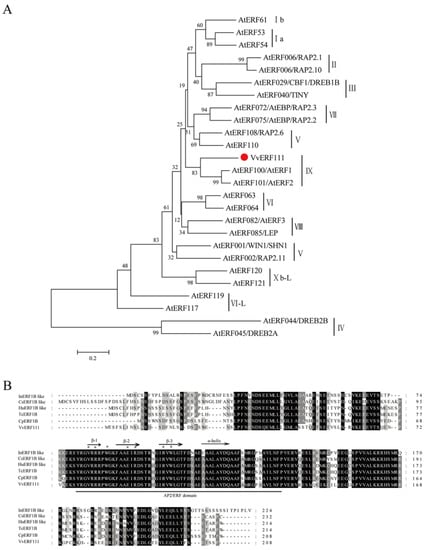
Figure 1.
Sequence analysis of VvERF111. (A) Phylogenetic analysis of VvERF111 and the ERF proteins from Arabidopsis thaliana representing each of the 12 families. (B) Multiple amino acid sequence alignment of VvERF111 and homologous proteins from Ipomoea nil (XP_019181066), Camellia sinensis (XP_028082616), Herrania umbratica (XP_021290986), Theobroma cacao (EOY06019), and Carica papaya (XP_021899534). Black line underlined letters represent AP2/ERF domain. Predicted α-helix and β-sheet regions were denoted with black bar and arrows. Asterisks represent amino acid residues that directly make contact with DNA.
3.2. Expression of VvERF111 and VvCLH1 Induced by Ethylene
In Shine Muscat grape, the rachis gradually browns during post-harvest storage, and 1-MCP treatment can delay rachis browning, according to our previous reports [12,22]. The transcriptional response of VvERF111 and VvCLH1 in the rachis was examined following treatment with 1-MCP or ethylene at 0, 4, 12, 24, and 48 h. The transcript levels of VvERF111 and VvCLH1 increased after ethylene treatment and decreased after 1-MCP treatment (Figure 2A,B). This suggested that ethylene affected the expression of VvERF111 and VvCLH1. The expression of VvERF111 and VvCLH1 were similar (Supplemental Table S2) [12]. The DRE motif, which binds ERF transcription factors, was found in the promoter of VvCLH1. This prompted the hypothesis that VvERF111 regulates the expression of VvCLH1, thus participating in ethylene induced degradation of chlorophyll.
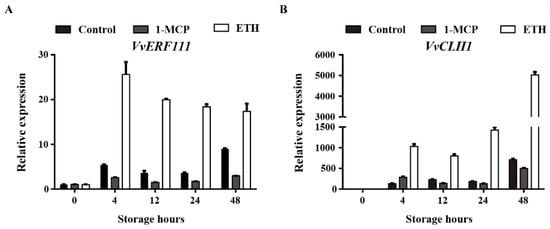
Figure 2.
Expression of VvERF111 (A) and VvCLH1 (B) during rachis browning of grape and their responses to ethylene and 1-MCP treatments. Data represented mean ± SE from three independent biological replicates.
3.3. Analysis of VvERF111 Subcellular Localization and Transcriptional Activation Activity
To identify the molecular mechanisms of VvERF111-mediated Chl degradation, the ability of VvERF111 to serve as a transcription factor was assessed through determining its subcellular location and transcriptional activation properties. The CDS of VvERF111 was introduced into the pGBKT7 vector. The pGBKT7- VvERF111 construct was transformed into strain Y2HGold, with the empty pGBKT7 vector used as control. pGBKT7-VvERF111 and pGBKT7 grew normally on SDO, but only pGBKT7-VvERF111 could survive on SDO/A and turn blue on SDO/A/X (Figure 3A). This indicated that VvERF111 could activate transcriptional in yeast.
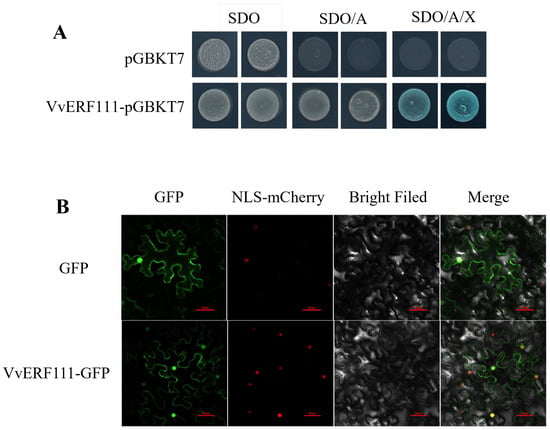
Figure 3.
Transcriptional activation in yeast and subcellular localization in tobacco of VvERF111. (A) VvERF111 transactivation activity assay. SDO: synthetic dropout medium; SDO/A: synthetic dropout medium lacking tryptophan and supplemented with Aureobasidin A; and SD/AbA/X: synthetic dropout medium lacking tryptophan and supplemented with Aureobasidin A and X-a-Gal. pGBKT7 vector was used as negative control. (B) Subcellular localization of VvERF111 in Nicotiana benthamiana leaves, the colored dots represent nucleus. Bright field, white light; merged, combined GFP, and brightfield signals. pBI221-mCherry fusing the NLS (amino acid sequence PKKKRKV) to a red fluorescent protein was used as nuclear-localized marker. Bar = 50 μm.
A nuclear localization signal (NLS) signal is included in the VvERF111 sequence, indicating that VvERF111 maybe a nuclear protein. To confirm this speculation, the CDS of VvERF111 was fused with GFP under the control of the CaMV35S promoter. The 35S-VvERF111-GFP and 35S-GFP constructs were transformed into N. benthamiana leaves. The green fluorescence of VvERF111-GFP was observed at both the cell membrane and in all nuclei stained with mCherry (Figure 3B, lower panels). The GFP only signal was detected in one nucleus and diffusely in the cell, including at the membrane (Figure 3B). The results suggested that VvERF111 was localized in both the nucleus and the membrane.
3.4. VvERF111 Activates Expression of the VvCLH1 Promoter
To investigate the ability of VvERF111 to bind to the promoter of VvCLH1 and other chlorophyll degradation genes, the promoters of VvSGR, VvSGRL, VvCLH1, VvPAO1, VvRCCR, and VvNOL were fused into the pLaczi vector, and the CDS of VvERF111 was fused into the pB42AD vector. The constructs were co-transformed in pairs into the yeast strain EGY48. The results indicated that VvERF111 could bind the VvCLH1 promoter (Figure 4A). Dual-luciferase reporter assays were carried out to test whether VvERF111 was directly activating or suppressing the expression VvCLH1. The results showed that the LUC activity was significantly enhanced with co-tranformed of VvERF111 and the VvCLH1 promoter compared to the control (Figure 4B), which indicated that VvERF111 positively regulates the expression of VvCLH1.
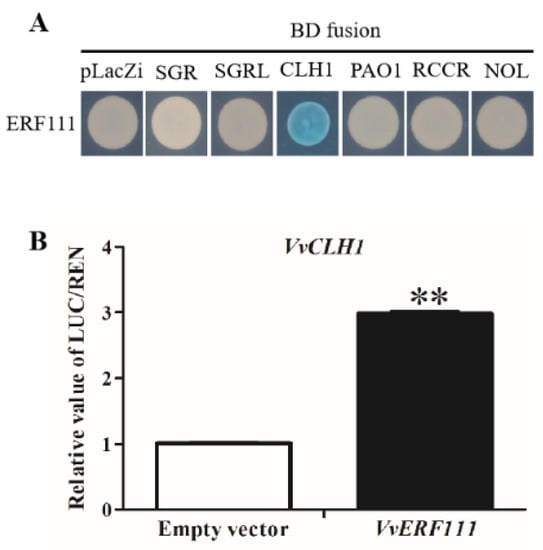
Figure 4.
Interaction of the VvERF111 protein with the promoter of VvCLH1. (A) Yeast one hybrid assays to detect the binding of VvERF111 on the promoters of chlorophyll degradation genes. (B) Dual-LUC experiment to detect the regulation of the VvCLH1 promoter by VvERF111, and the pSAK277 empty vector co-transformed with promoter of VvCLH1 was used as negative control. Data represented mean ± SE from three independent biological replicates; ** represents significance at p < 0.01.
To find the potential binding motifs in the promoter of VvCLH1, the promoter of VvCLH1 was truncated into three segments (p1, p2, and p3). Yeast one-hybrid analysis was carried out with VvERF111. The farthest promoter fragment, p1, could be activated by VvERF111 (Figure 5A). The p1 segment was then further divided into six fragments, which were then co-transformed with VvERF111 into EGY48. The results showed that VvERF111 could bind to fragment p1–3, which contained one DRE motif (GGCTG) (Figure 5B). Mutation in the p1–3 fragment indicated that VvERF111 binds the DRE cis-acting element (GGCTG) of the VvCLH1 promoter (Figure 5C). We therefore deduced that VvERF111 could bind to the DRE motif in the promoter of VvCLH1.
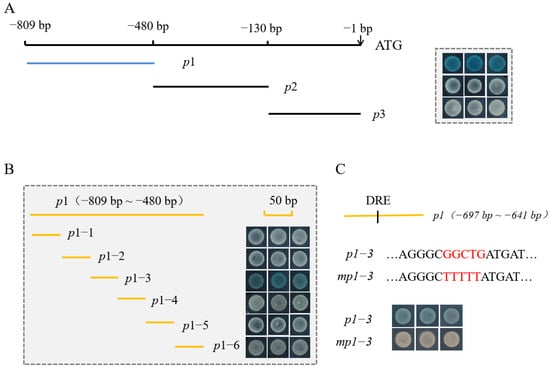
Figure 5.
Sequential deletion and mutation of the VvCLH1 promoter to detect the cis-element that can interact with VvERF111. (A,B) A sequential deletion series and (C) a mutant of the VvCLH1 promoter were analyzed in yeast one-hybrid assays expressing VvERF111. The blue line represent the segment which VvERF111 binding, and the DRE motif and its mutant indicated in red.
3.5. Transient Overexpression of VvERF111 and VvCLH1 Promoted Chlorophyll Degradation in Grape
Since obtaining stable transgenic grape plants would take a long time, the transient overexpression of VvERF111 and VvCLH1 in grape leaves was used to determine if VvERF111 and VvCLH1 could influence chlorophyll degradation, and Agrobacterium tumefaciens cultures containing the 35S-VvERF111-GFP and 35S-VvCLH1-GFP expression cassettes were vacuum-infiltrated into grape leaves and observed 3 d later. The expression of VvERF111 and VvCLH1 was increased after transient over-expression of the same gene (Figure 6C and left of 6D). The leaves transiently over-expressing VvERF111 or VvCLH1 were yellowed compared with the control (Figure 6A), which indicates a lower content of chlorophyll. Transgenic leaves overexpressing VvERF111 or VvCLH1 contained significantly decreased chlorophyll content (Figure 6B). In addition, qRT-qPCR analysis revealed that the transcript levels of VvCLH1 were significantly higher when only VvERF111 was overexpressed (Figure 6D). This alteration was consistent with our hypothesis that VvERF111 could regulate the degradation of chlorophyll by regulating the expression of VvCLH1.
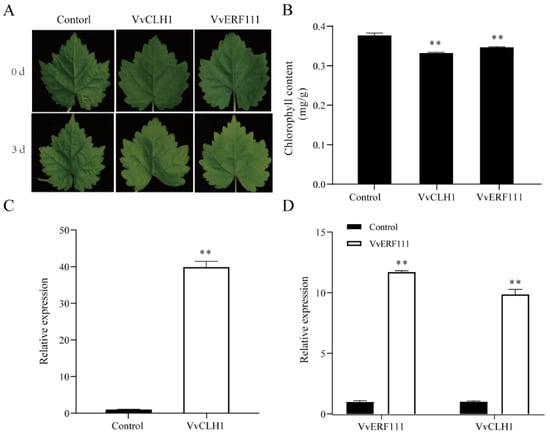
Figure 6.
Transient overexpression of VvERF11 and VvCLH1 in grape leaves. (A) Color changes of grape leaves over-expressing VvERF111 and VvCLH1. (B) Chlorophyll content in grape leaves after VvERF111 and VvCLH1 transient over-expression in grape leaves. (C) Expression of VvCLH1 in grape leaves with transient over-expression of VvCLH1. (D) Expression of VvERF111 and VvCLH1 in grape leaves with transient over-expression of VvERF111. Leaves transformed with 35S-GFP were used as control, data represented mean ± SE from three independent biological replicates, and ** represents significance at p < 0.01.
4. Discussion
Color is a critical index for fruit quality, and in grape, the color of both the rachis and the fruit affect consumer choice. Rachis browning in grape affects storage longevity and consumer selection of a grape cluster, decreasing its commercial value. Grape is a non-climacteric fruit; however, ethylene is released from the rachis during post-harvest storage and is an important factor in rachis browning [12,15,22]. Ethylene can induce chlorophyll degradation [12,13,22]; however, the mechanism underlying ethylene-induced chlorophyll degradation remains less studied in grape rachis. The transcriptional regulation of chlorophyll degradation by ERF transcription factors has been widely studied during the degreening of the peel, while the fruit is ripening or being stored after harvest [5,11,30,31,32]. ERF transcription factors can bind to DRE or GCC-box motifs in promoters of chlorophyll degradation genes, thus regulating their expression [5,12,20]. ERFs are classified into 12 subfamilies [29,33], and VvERF111 belongs to the ERF IX subfamily, which contains 40 members [33]. VvERF111 has the conserved AP2/ERF domain (Figure 2), similar to VvERF95 and VvERF75 in the same subfamily [12]; however, the roles of most genes in this subfamily in grape remain unknown.
Chlorophyll content is decreased during rachis browning and the fruit coloration of grape [12,17,21], while the expression of VvERF95, VvERF75, and VvERF17 increases. VvERF95 and VvERF75 regulate chlorophyll degradation during rachis browning and fruit ripening, respectively, by binding to the DRE motif in the promoter of VvPAO1 [12,21], while VvERF17 regulates chlorophyll content in grape skin by positively regulating the expression of NOL, PPH, PAO, and RCCR [17]. During citrus fruit degreening, the expression levels of CitERF13, CitERF6, and chlorophyll degradation genes increase, while chlorophyll content deceases. CitERF13 and CitERF6 trigger chlorophyll degradation by binding the promoter of CitPPH and activating its expression [4,20]. During apple peel degreening, MdERF17 regulates the expression of NYC and PPH. The binding of ERF17 to chlorophyll degradation-related genes is affected by the number of Ser repeats [5,34]. The phosphorylation of MdERF17 at residue Thr67 by MdMPK4-14G is necessary for its transcriptional regulatory activity and its regulation of Chl degradation [21]. In banana, the expression of MaERF012 is closely related to fruit ripening, and MaERF012 activates the promoter of MaSGR1 during fruit ripening [35]. Together, these studies suggest that ERF transcription factors have conserved functions in controlling chlorophyll degradation in fruit trees.
We previously showed that VvERF111 showed higher expression levels during rachis browning and that its expression was positively correlated with the expression of chlorophyll degradation genes and negatively correlated with content of chlorophyll [22]. We proposed that VvERF111 may regulate chlorophyll degradation. The results of yeast one-hybrid and dual-LUC assays suggested that VvERF111 could positively regulate the expression of VvCLH1 by binding to the DRE motif in the promoter of VvCLH1 (Figure 4 and Figure 5), similar to previous reports [12]. VvERF111 and VvCLH1 had higher expression during rachis browning [22], and the expression of VvERF111 could be induced by ethylene and inhibited by 1-MCP (Figure 1). A similar response of VvCLH1 was detected, which indicated that the expression of these two genes in grape rachis was controlled by ethylene. This is consistent with previous research on the effect of ethylene on chlorophyll degradation [18].
The transient over-expression of VvERF111 and VvCLH1 in grape leaves resulted in decreased chlorophyll content compared to the control (Figure 6A,B), which indicated that these two genes had important functions in chlorophyll catabolism. In leaves transiently overexpressing VvERF111, the expression of VvCLH1 was increased, further validating the idea that VvERF111 activated the expression of VvCLH1. In addition to chlorophyll degradation, reduced biosynthesis can also lower the content of chlorophyll. A recent study in tomato showed that SlERF.J2 regulates chlorophyll accumulation by suppressing the expression of genes related to chlorophyll synthesis [18]. Any potential ERF transcription factor in grape that regulates chlorophyll biosynthesis will be sought in future studies.
Our results revealed that the AP2/ERF transcription factor VvERF111 localized in the nucleus and at the cell membrane, that both VvERF111 and VvCLH1 are ethylene-inducible genes, and that VvERF111 could regulate chlorophyll degradation during rachis browning by binding to the DRE motif in the promoter of VvCLH1. This research adds to our understanding of the mechanisms underlying rachis browning in the clusters of table grapes.
Supplementary Materials
The following supporting information can be downloaded at https://www.mdpi.com/article/10.3390/horticulturae9040438/s1. Table S1: Primers used in this study. Table S2: Transcriptome analysis of the expression of VvERF111 and VvCLH1 during rachis browning.
Author Contributions
Conceptualization, D.Z., J.L., Z.L. and J.F.; methodology, D.Z., J.L., J.C. and X.Y.; software, D.Z., J.L., Z.L. and B.T.; validation, D.Z., J.L., X.Z. and W.W.; formal analysis, D.Z., J.L. and Z.L.; investigation, D.Z., J.L. and X.Y.; resources, X.Y., X.Z. and J.F.; data curation, D.Z., J.L. and B.T.; writing—original draft preparation, D.Z. and Z.L.; writing—review and editing, X.Y. and J.F.; supervision, J.C. and W.W.; and funding acquisition, Z.L., X.Y. and J.F. All authors have read and agreed to the published version of the manuscript.
Funding
This work was supported by the Key Scientific Research Project of Henan Province Colleges and Universities (Grant No. 21A210021), the National Natural Science Foundation of China (Grant No. 32002017), a Postdoctoral Research Grant in Henan Province (Grant No. 202002054), the Henan Province Outstanding Foreign Scholar Program (Grant No. GZS2020007), and the Natural Science Foundation of Henan Province (Grant No. 222300420457).
Institutional Review Board Statement
Not applicable.
Informed Consent Statement
Not applicable.
Data Availability Statement
All data generated or analyzed during this study are included in this published article and its supplementary information files.
Conflicts of Interest
The authors declare that they have no conflict of interest.
References
- Lichter, A. Rachis browning in tablegrapes. Aust. J. Grape Wine Res. 2016, 22, 161–168. [Google Scholar] [CrossRef]
- Lichter, A.; Kaplunov, T.; Zutahy, Y.; Daus, A.; Alchanatis, V.; Ostrovsky, V.; Lurie, S. Physical and visual properties of grape rachis as affected by water vapor pressure deficit. Postharvest Biol. Technol. 2011, 59, 25–33. [Google Scholar] [CrossRef]
- Takamiya, K.I.; Tsuchiya, T.; Ohta, H. Degradation pathway(s) of chlorophyll: What has gene cloning revealed? Trends Plant Sci. 2000, 5, 426–431. [Google Scholar] [CrossRef] [PubMed]
- Yin, X.R.; Xie, X.L.; Xia, X.J.; Yu, J.Q.; Ferguson, I.B.; Giovannoni, J.J.; Chen, K.S. Involvement of an ethylene response factor in chlorophyll degradation during citrus fruit degreening. Plant J. 2016, 86, 403–412. [Google Scholar] [CrossRef]
- Han, Z.; Hu, Y.; Lv, Y.; Rose, J.K.C.; Sun, Y.; Shen, F.; Wang, Y.; Zhang, X.; Xu, X.; Wu, T.; et al. Natural Variation Underlies Differences in ETHYLENE RESPONSE FACTOR17 Activity in Fruit Peel Degreening. Plant Physiol. 2018, 176, 2292–2304. [Google Scholar] [CrossRef] [PubMed]
- Park, S.Y.; Yu, J.W.; Park, J.S.; Li, J.; Yoo, S.C.; Lee, N.Y.; Lee, S.K.; Jeong, S.W.; Seo, H.S.; Koh, H.J.; et al. The senescence-induced staygreen protein regulates chlorophyll degradation. Plant Cell 2007, 19, 1649–1664. [Google Scholar] [CrossRef] [PubMed]
- Schenk, N.; Schelbert, S.; Kanwischer, M.; Goldschmidt, E.E.; Dormann, P.; Hortensteiner, S. The chlorophyllases AtCLH1 and AtCLH2 are not essential for senescence-related chlorophyll breakdown in Arabidopsis thaliana. FEBS Lett. 2007, 581, 5517–5525. [Google Scholar] [CrossRef] [PubMed]
- Hortensteiner, S. Stay-green regulates chlorophyll and chlorophyll-binding protein degradation during senescence. Trends Plant Sci. 2009, 14, 155–162. [Google Scholar] [CrossRef]
- Harpaz-Saad, S.; Azoulay, T.; Arazi, T.; Ben-Yaakov, E.; Mett, A.; Shiboleth, Y.M.; Hortensteiner, S.; Gidoni, D.; Gal-On, A.; Goldschmidt, E.E.; et al. Chlorophyllase is a rate-limiting enzyme in chlorophyll catabolism and is posttranslationally regulated. Plant Cell 2007, 19, 1007–1022. [Google Scholar] [CrossRef]
- Chen, L.-F.O.; Lin, C.-H.; Kelkar, S.M.; Chang, Y.-M.; Shaw, J.-F. Transgenic broccoli (Brassica oleracea var. italica) with antisense chlorophyllase (BoCLH1) delays postharvest yellowing. Plant Sci. 2008, 174, 25–31. [Google Scholar] [CrossRef]
- Liu, W.; Li, Q.; Wang, Y.; Wu, T.; Yang, Y.; Zhang, X.; Han, Z.; Xu, X. Ethylene response factor AtERF72 negatively regulates Arabidopsis thaliana response to iron deficiency. Biochem. Biophys. Res. Commun. 2017, 491, 862–868. [Google Scholar] [CrossRef] [PubMed]
- Li, Z.Q.; Li, J.W.; Ye, X.; Zheng, X.B.; Tan, B.; Li, J.D.; Cheng, J.; Wang, W.; Zhang, L.L.; Wang, X.B.; et al. VvERF95 regulates chlorophyll degradation by transcriptional activation of VvPAO1 causing grape rachis degreening after harvesting. Sci. Hortic. 2022, 303, 111224. [Google Scholar] [CrossRef]
- Ye, X.; Zheng, X.; Zhai, D.; Song, W.; Tan, B.; Li, J.; Feng, J. Expression Patterns of ACS and ACO Gene Families and Ethylene Production in Rachis and Berry of Grapes. HortScience 2017, 52, 413–422. [Google Scholar] [CrossRef]
- Li, L.; Kaplunov, T.; Zutahy, Y.; Daus, A.; Porat, R.; Lichter, A. The effects of 1-methylcyclopropane and ethylene on postharvest rachis browning in table grapes. Postharvest Biol. Technol. 2015, 107, 16–22. [Google Scholar] [CrossRef]
- Wang, L.; Luo, Z.; Li, J.; Yang, M.; Yan, J.; Lu, H.; Li, D.; Chen, C.; Aghdam, M.S.; Wu, B.; et al. Morphological and quality characterization of grape berry and rachis in response to postharvest 1-methylcyclopropene and elevated oxygen and carbon dioxide atmospheres. Postharvest Biol. Technol. 2019, 153, 107–117. [Google Scholar] [CrossRef]
- Cheng, Y.; Dong, Y.; Yan, H.; Ge, W.; Shen, C.; Guan, J.; Liu, L.; Zhang, Y. Effects of 1-MCP on chlorophyll degradation pathway-associated genes expression and chloroplast ultrastructure during the peel yellowing of Chinese pear fruits in storage. Food Chem. 2012, 135, 415–422. [Google Scholar] [CrossRef] [PubMed]
- Lu, S.; Zhang, M.; Zhuge, Y.; Fu, W.; Ouyang, Q.; Wang, W.; Ren, Y.; Pei, D.; Fang, J. VvERF17 mediates chlorophyll degradation by transcriptional activation of chlorophyll catabolic genes in grape berry skin. Environ. Exp. Bot. 2022, 193, 104678. [Google Scholar] [CrossRef]
- Chen, Y.; Cai, X.; Tang, B.; Xie, Q.; Chen, G.; Chen, X.; Hu, Z. SlERF.J2 Reduces Chlorophyll Accumulation and Inhibits Chloroplast Biogenesis and Development in Tomato Leaves. Plant Sci. 2023, 328, 111578. [Google Scholar] [CrossRef]
- Liu, W.; Karemera, N.J.U.; Wu, T.; Yang, Y.; Zhang, X.; Xu, X.; Wang, Y.; Han, Z. The ethylene response factor AtERF4 negatively regulates the iron deficiency response in Arabidopsis thaliana. PLoS ONE 2017, 12, e0186580. [Google Scholar] [CrossRef]
- Li, S.J.; Xie, X.L.; Liu, S.C.; Chen, K.S.; Yin, X.R. Auto- and mutual-regulation between two CitERFs contribute to ethylene-induced citrus fruit degreening. Food Chem. 2019, 299, 125163. [Google Scholar] [CrossRef]
- Li, Z.Q.; Chen, C.Y.; Zou, D.F.; Li, J.W.; Huang, Y.Y.; Zheng, X.B.; Tan, B.; Cheng, J.; Wang, W.; Zhang, L.L.; et al. Ethylene accelerates grape ripening via increasing VvERF75-induced ethylene synthesis and chlorophyll degradation. Fruit Res. 2023, 3, 1–9. [Google Scholar] [CrossRef]
- Zhang, S.T.; Fu, M.M.; Li, Z.Q.; Li, J.W.; Hai, L.F.; Chen, C.Y.; Zheng, X.B.; Tan, B.; Li, J.D.; Cheng, J.; et al. VvEIL2 and VvEIL4 regulate ethylene synthesis and carotenoid metabolism during senescence of grape rachis. Postharvest Biol. Technol. 2022, 187, 111853. [Google Scholar] [CrossRef]
- Li, Z.; Zhang, C.; Guo, Y.; Niu, W.; Wang, Y.; Xu, Y. Evolution and expression analysis reveal the potential role of the HD-Zip gene family in regulation of embryo abortion in grapes (Vitis vinifera L.). BMC Genom. 2017, 18, 744. [Google Scholar] [CrossRef] [PubMed]
- Li, Z.; Jiao, Y.; Zhang, C.; Dou, M.; Weng, K.; Wang, Y.; Xu, Y. VvHDZ28 positively regulate salicylic acid biosynthesis during seed abortion in Thompson Seedless. Plant Biotechnol. J. 2021, 19, 1824–1838. [Google Scholar] [CrossRef]
- Hellens, R.P.; Allan, A.C.; Friel, E.N.; Bolitho, K.; Grafton, K.; Templeton, M.D.; Karunairetnam, S.; Gleave, A.P.; Laing, W.A. Transient expression vectors for functional genomics, quantification of promoter activity and RNA silencing in plants. Plant Methods 2005, 1, 13. [Google Scholar] [CrossRef] [PubMed]
- Sainsbury, F.; Thuenemann, E.C.; Lomonossoff, G.P. pEAQ: Versatile expression vectors for easy and quick transient expression of heterologous proteins in plants. Plant Biotechnol. J. 2009, 7, 682–693. [Google Scholar] [CrossRef]
- Yao, W.; Wang, L.; Wang, J.; Ma, F.; Yang, Y.; Wang, C.; Tong, W.; Zhang, J.; Xu, Y.; Wang, X.; et al. VpPUB24, a novel gene from Chinese grapevine, Vitis pseudoreticulata, targets VpICE1 to enhance cold tolerance. J. Exp. Bot. 2017, 68, 2933–2949. [Google Scholar] [CrossRef]
- Livak, K.J.; Schmittgen, T.D. Analysis of relative gene expression data using real-time quantitative PCR and the 2(-Delta Delta C(T)) Method. Methods 2001, 25, 402–408. [Google Scholar] [CrossRef]
- Nakano, T.; Suzuki, K.; Fujimura, T.; Shinshi, H. Genome-wide analysis of the ERF gene family in Arabidopsis and rice. Plant Physiol. 2006, 140, 411–432. [Google Scholar] [CrossRef]
- Rauf, M.; Arif, M.; Dortay, H.; Matallana-Ramírez, L.P.; Waters, M.T.; Gil Nam, H.; Lim, P.O.; Mueller-Roeber, B.; Balazadeh, S. ORE1 balances leaf senescence against maintenance by antagonizing G2-like-mediated transcription. EMBO Rep. 2013, 14, 382–388. [Google Scholar] [CrossRef]
- Schaller, G.E.; Qiu, K.; Li, Z.; Yang, Z.; Chen, J.; Wu, S.; Zhu, X.; Gao, S.; Gao, J.; Ren, G.; et al. EIN3 and ORE1 Accelerate Degreening during Ethylene-Mediated Leaf Senescence by Directly Activating Chlorophyll Catabolic Genes in Arabidopsis. PLoS Genet. 2015, 11, e1005399. [Google Scholar] [CrossRef]
- Gao, S.; Gao, J.; Zhu, X.; Song, Y.; Li, Z.; Ren, G.; Zhou, X.; Kuai, B. ABF2, ABF3, and ABF4 Promote ABA-Mediated Chlorophyll Degradation and Leaf Senescence by Transcriptional Activation of Chlorophyll Catabolic Genes and Senescence-Associated Genes in Arabidopsis. Mol. Plant 2016, 9, 1272–1285. [Google Scholar] [CrossRef] [PubMed]
- Licausi, F.; Giorgi, F.M.; Zenoni, S.; Osti, F.; Pezzotti, M.; Perata, P. Genomic and transcriptomic analysis of the AP2/ERF superfamily in Vitis vinifera. BMC Genom. 2010, 11, 719. [Google Scholar] [CrossRef] [PubMed]
- Wang, S.; Wang, T.; Li, Q.; Xu, C.; Tian, J.; Wang, Y.; Zhang, X.; Xu, X.; Han, Z.; Wu, T. Phosphorylation of MdERF17 by MdMPK4 promotes apple fruit peel degreening during light/dark transitions. Plant Cell 2022, 34, 1980–2000. [Google Scholar] [CrossRef]
- Chen, H.; Lai, X.; Wang, L.; Li, X.; Chen, W.; Zhu, X.; Song, Z. Ethylene Response Factor MaERF012 Modulates Fruit Ripening by Regulating Chlorophyll Degradation and Softening in Banana. Foods 2022, 11, 3882. [Google Scholar] [CrossRef]
Disclaimer/Publisher’s Note: The statements, opinions and data contained in all publications are solely those of the individual author(s) and contributor(s) and not of MDPI and/or the editor(s). MDPI and/or the editor(s) disclaim responsibility for any injury to people or property resulting from any ideas, methods, instructions or products referred to in the content. |
© 2023 by the authors. Licensee MDPI, Basel, Switzerland. This article is an open access article distributed under the terms and conditions of the Creative Commons Attribution (CC BY) license (https://creativecommons.org/licenses/by/4.0/).